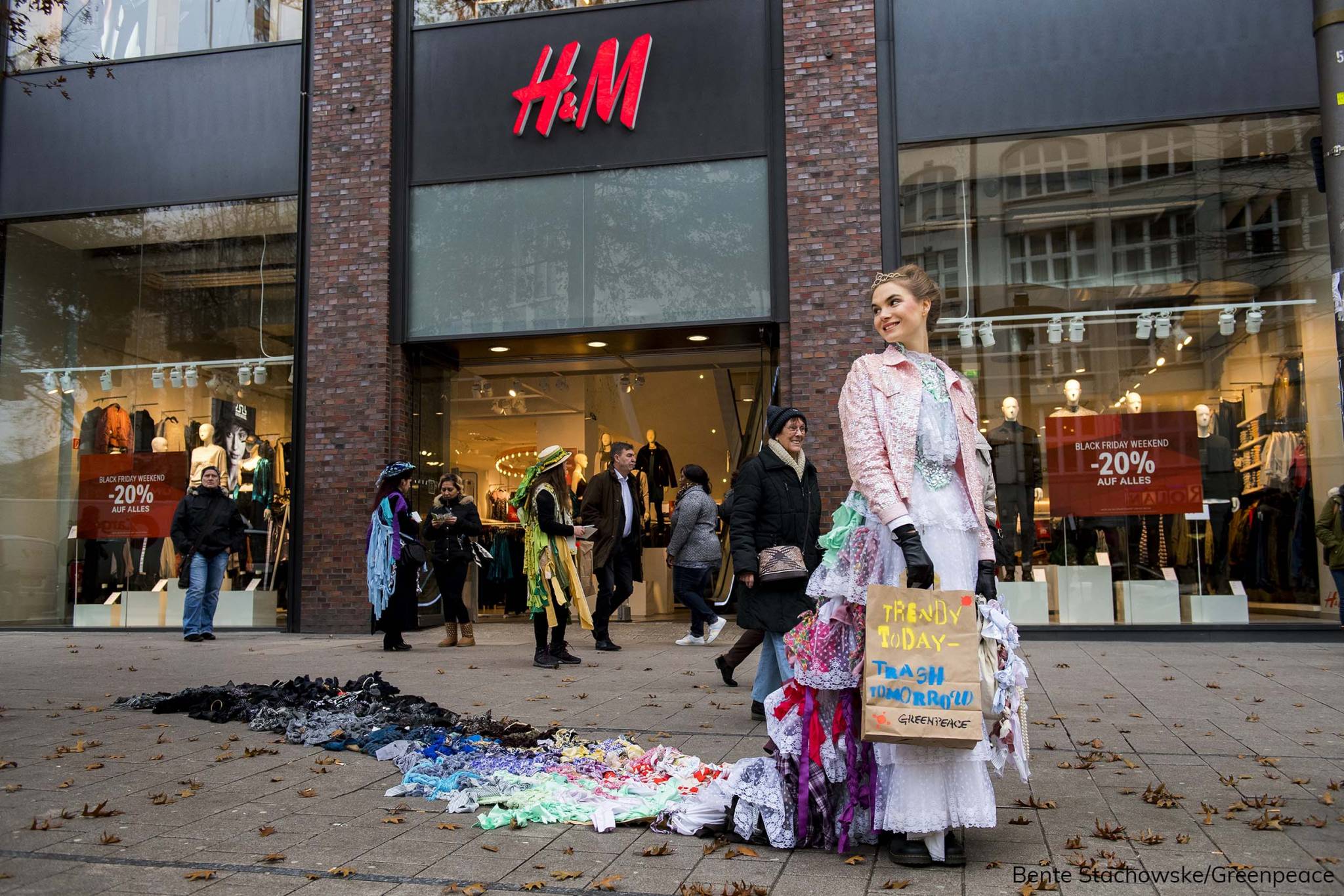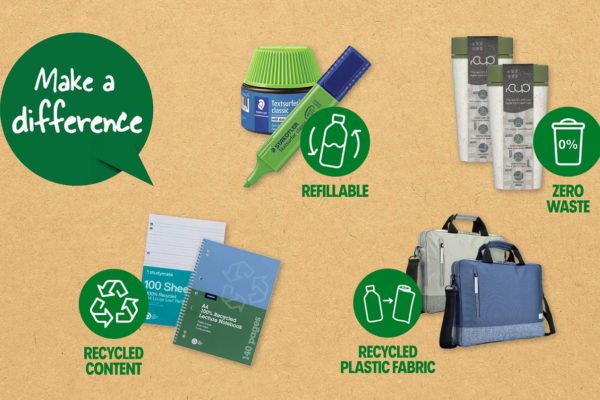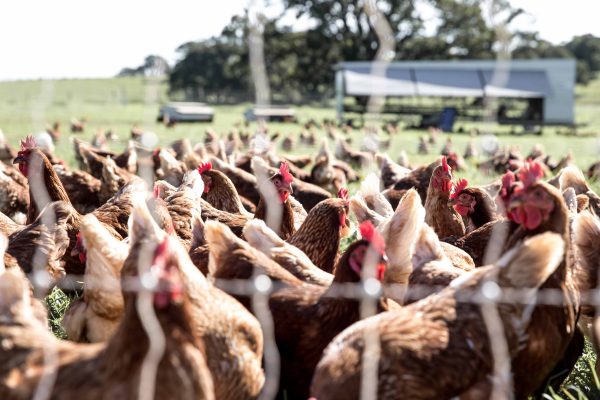The IPCC report that came out in October was terrifying.
It painted a future of drastically more wildfires, more drought, more heat, more and stronger hurricanes, more famine, and as a result, hundreds of millions of deaths and massive waves of migration that will dwarf what we are currently seeing. It could lead to the collapse of civilization… unless we invest in “transformational adaptation.”
In short, we will have to reinvent how we live in the world – and that includes how we consume fashion.
Image Bente Stachowske/Greenpeace

What does fashion have to do with climate change? Everything. According to the 2017 Pulse of the Fashion Industry report, the fashion industry was responsible for 1,715 million tons of CO2 in 2015, or about 4.3% of global carbon emissions.
With its complex supply chain, the fashion industry requires inputs from many of the most polluting industries: dirty power for factories, petroleum to make polyester, shipping, and leather and wool from livestock. The most polluting industry on the planet, agriculture, provides us with cotton and linen.
What we wear is linked to the type of future we’ll have.
How Much Power Do We Have As Consumers?
The thing is, much of the emissions happening around the world are completely out of our control.
For example, the IPCC report points to cement and steel manufacturing as two industries responsible for a disproportionate amount of global emissions. Seen in this context, the strenuous exhortation to “just stop buying from these polluting corporations and they’ll stop making this stuff,” is laughably out of touch. (Unless you’re a developer or currently building your dream home, then please do consider alternative materials.)
The complexity of the fashion supply chain also confounds our efforts as individual consumers. When you’re considering what shirt to purchase, do you inquire about whether the factory that sewed it and the factories that milled and made the cotton run on clean energy, coal, or dirty diesel generators?
Of course not. No consumer should be expected to dive that deeply into the supply chain of every purchase.
Is There an Easier Way to Be a Sustainable Fashion Consumer?
To simplify the process of choosing good fashion, we could demand the Sustainable Apparel Coalition finally role out their long-awaited labels measuring the impact of our clothing. They would function as fashion’s version of Australia’s ACO or the USDA organic label, allowing you to compare two similar products and – in a matter of seconds – choose the less polluting one.
But there are some serious drawbacks to this approach. One is that unlike food and beauty, consumers don’t see the impact of buying clean products on their health, so they’re less likely to be motivated to choose cleaner products. Consumers talk a big game about how they would pay more for eco products. But in practice, consumers care more about the ease of purchase, and what value they’re getting for the price.
You’re human. We’re all human. And we want to look beautiful and not go in debt to do so.
Here’s an approach that even a five-year-old can understand: buy less stuff.
“Overall, of course, the best thing the industry could do is produce/sell much less,” Linda Greer of the NRDC told me in an email. “It is the massive throughput of this industry that is killing us. Things like Rent the Runway and buying vintage. So many of the other options for reductions just nibble around the edges.”
So let’s think BIG again. In 2011 residential buildings were responsible for 10.2% of global emissions. So the most impactful thing you could do as one person might be to move into a smaller living space outfitted with the latest energy-efficient technology.
What does this have to do with fast fashion?
Well, the happy side effect of this grand gesture is that you’ll likely have a smaller closet, or maybe even room for just a rolling rack. In which case, you’ll have to drastically reduce the amount of clothing and accessories you have, and consider each purchase carefully not just in terms of whether it fits in your budget, but whether it fits in your tiny bedroom. You can spend more on quality items that will last a long time, and supplement your closet with a rotating cast of rental fashion. That is the most sustainable thing to do. If only there were some fashion bloggers to help you do this…
Who Should Be Responsible for Fashion Pollution?
Minimalist wardrobes appeal to some people (including me. Sometimes). But I can imagine no world in which everyone voluntarily pares down to thirty items.
Perhaps we should demand the big fashion players take responsibility. They’re the ones making the clothes, and profiting, after all.
Some of the biggest things these fashion corporations can do to lower their carbon footprint is: shift to sustainable cotton, increase the recycled content of their materials, switch to suppliers who use clean energy and improve the energy efficiency of existing suppliers, and close the loop on fashion, so that we never throw any fashion in the landfill.
Some large fashion corporations are striving to do all these things. However, they represent only a fraction of the business, and the same names always seem to show up in the list: H&M, Inditex (Zara), Levi’s, Patagonia, C&A in Europe, Adidas, and Nike. What about the rest of the market? What about the faceless companies churning out cheap stuff with nary a care for consumer sentiment or loyalty?
It seems we need to force change, on everybody.
Rick Ridgeway of Patagonia told me a couple of years back exactly how to do that.
“As you think this through, you begin to realize that a carbon tax could have a very positive influence on reducing the [cost] difference between recycled and virgin polyester,” he said. “There’s a very clear linkage…And it can also be used to influence regenerative grazing, and of course, that potentially applies to sheep ranches and wool. So, we’re strongly in support of the price on carbon,” he concluded.
Could it be that simple, then? Could you be a more conscious fashion consumer not by sweating every single purchase, but by simply taking ten minutes to tell your government representatives that you want a carbon fee and dividend?
Sometimes the answer to a complicated question really is that simple.


